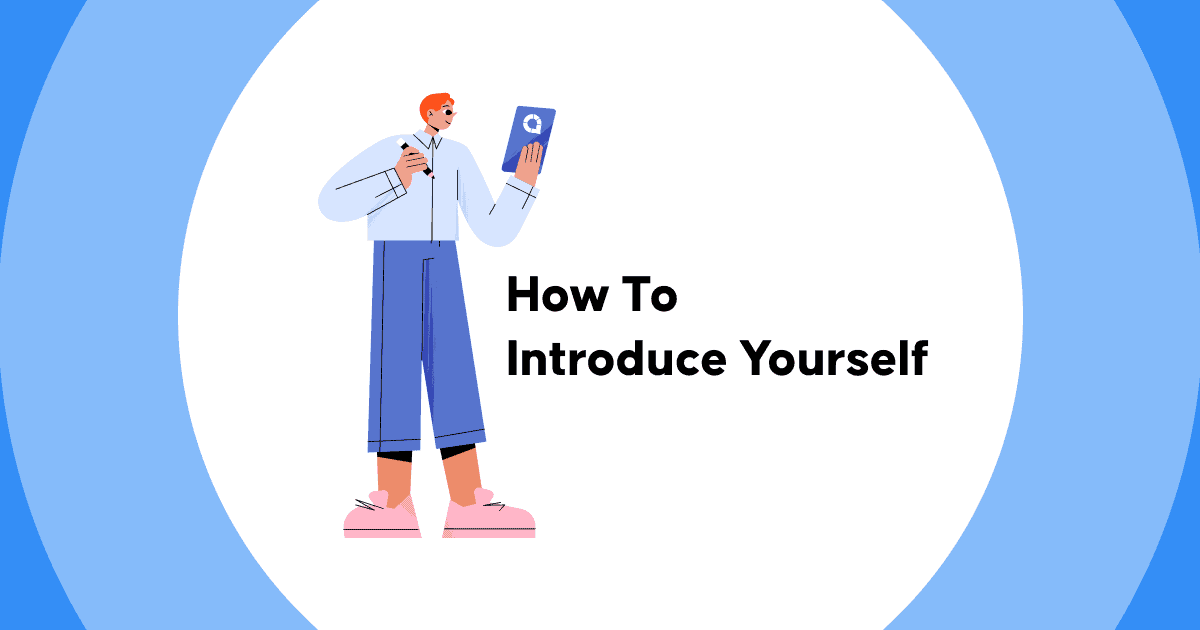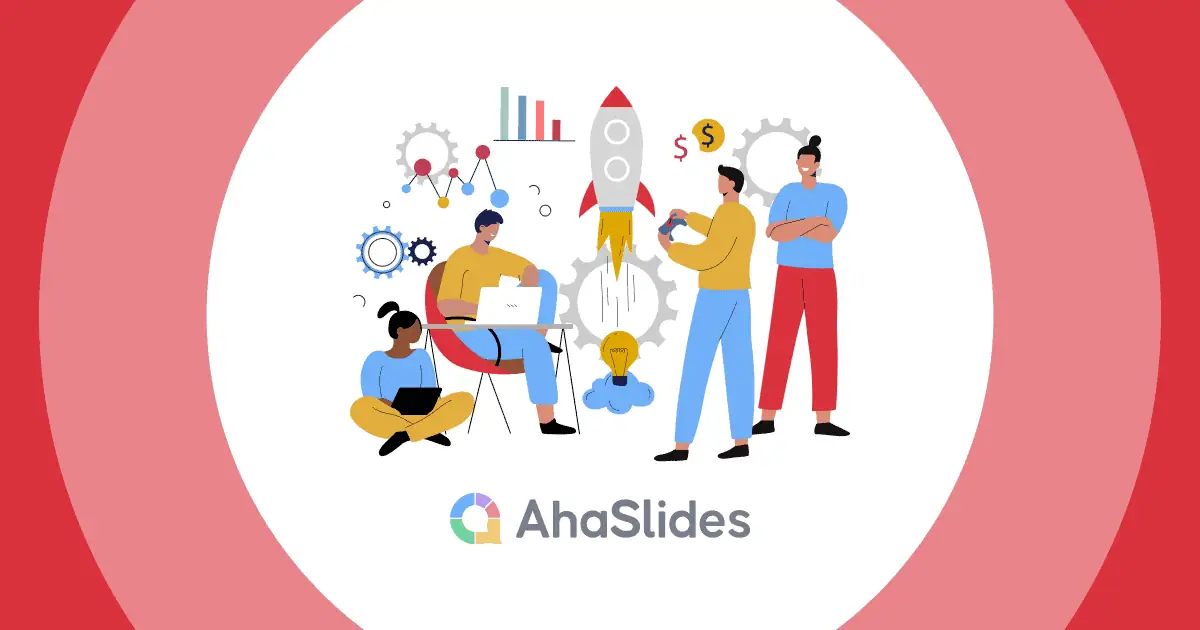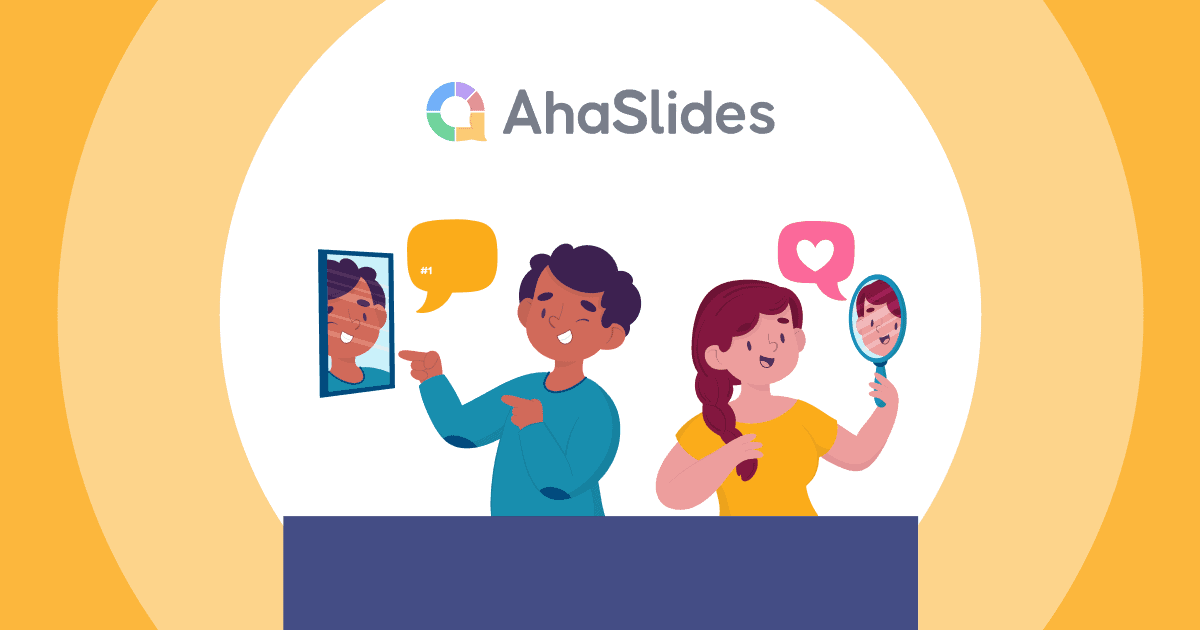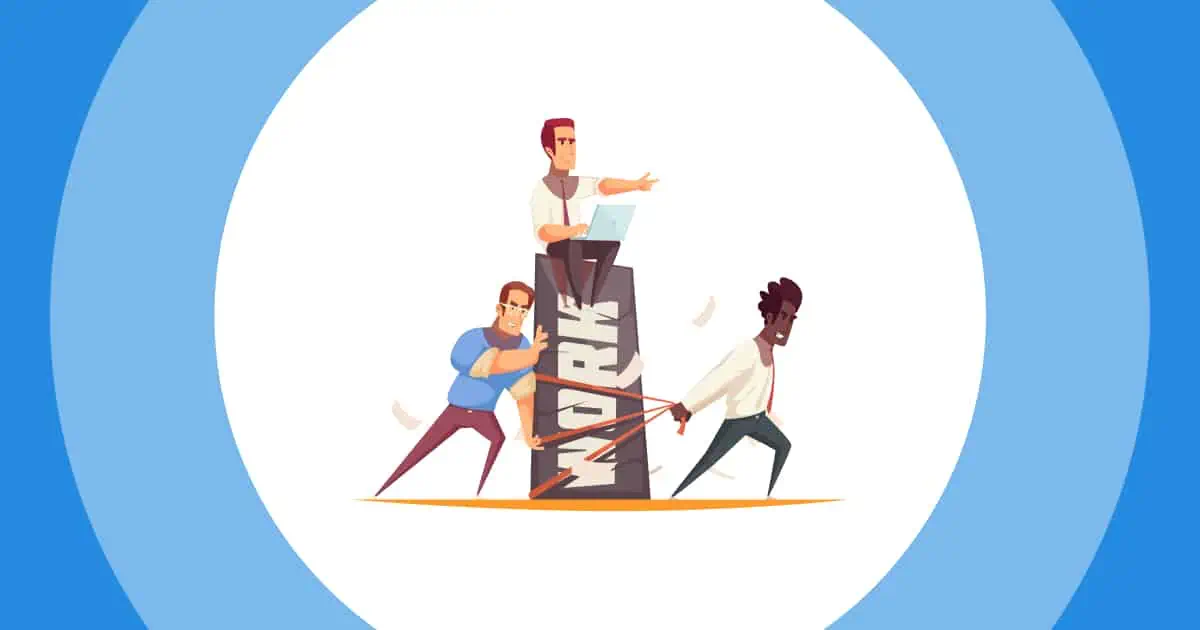W wystąpieniach publicznych najważniejsze jest pierwsze wrażenie. Niezależnie od tego, czy prowadzisz prezentację w sali liczącej 5 czy 500 osób, te kilka pierwszych chwil decyduje o tym, jak zostanie odebrana cała wiadomość.
Masz tylko jedną szansę na odpowiednie wprowadzenie, dlatego niezwykle ważne jest, aby ją dobrze wykorzystać.
Omówimy najlepsze wskazówki na temat jak się przedstawić podczas prezentacji. Na koniec wejdziesz na scenę z podniesioną głową, gotowy do rozpoczęcia przyciągającej uwagę prezentacji jak profesjonalista.
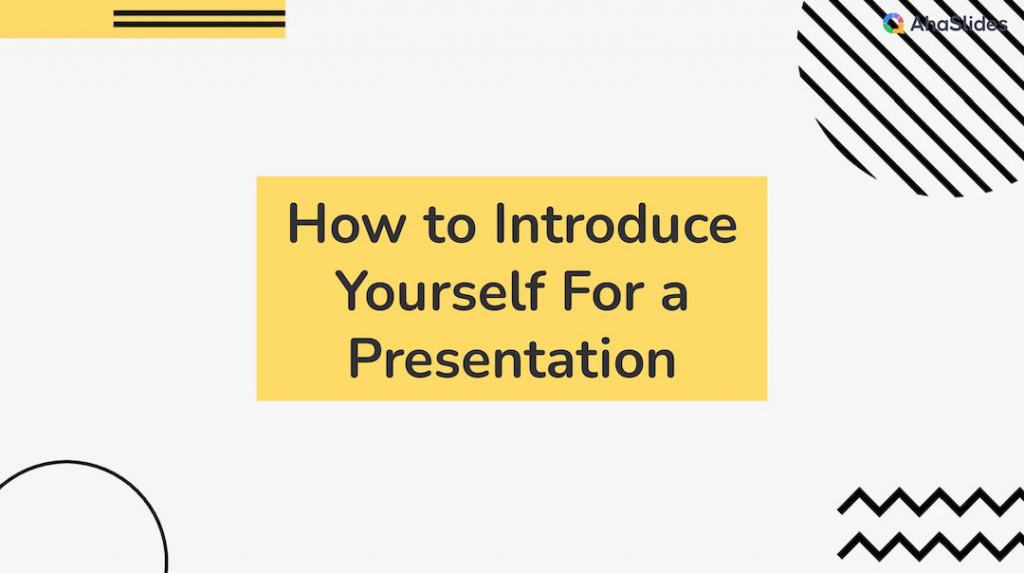
Spis treści
Wskazówki dotyczące zaangażowania odbiorców

Zacznij w kilka sekund.
Uzyskaj bezpłatne szablony do następnej interaktywnej prezentacji. Zarejestruj się za darmo i weź to, co chcesz z biblioteki szablonów!
🚀 Zdobądź darmowe konto
Jak się przedstawić podczas prezentacji (+Przykłady)
Dowiedz się, jak powiedzieć „cześć” w sposób, który pozostawi trwały ślad i sprawi, że Twoi odbiorcy będą chcieli więcej. Prezentacja wstępna należy do Ciebie — teraz weź ją!
#1. Rozpocznij temat angażującym haczykiem
Postaw otwarte wyzwanie związane z twoim doświadczeniem. „Gdybyś musiał poruszać się po złożonym problemie X, jak byś do tego podszedł? Jako ktoś, kto miał z tym do czynienia osobiście…”
Opowiedz o jakimś osiągnięciu lub szczególe dotyczącym twojego pochodzenia. „Czego wielu o mnie nie wie, to to, że kiedyś…”
Opowiedz krótką historię ze swojej kariery, która pokazuje twoje doświadczenie. „Był taki czas na początku mojej kariery, kiedy…”
Postaw hipotezę, a następnie opowiedz o tym na podstawie doświadczenia. „Co byś zrobił, gdybyś stanął twarzą w twarz z rozgniewanym klientem, tak jak ja kilka lat temu, kiedy…”

Odwołaj się do wskaźników sukcesu lub pozytywnych opinii, które potwierdzają Twój autorytet. „Kiedy ostatnio wygłosiłem prezentację na ten temat, 98% uczestników stwierdziło, że…”
Wspomnij, gdzie zostałeś opublikowany lub zaproszony do wystąpienia. „…dlatego organizacje takie jak [nazwy] poprosiły mnie o podzielenie się moimi spostrzeżeniami na ten temat”.
Zadaj otwarte pytanie i zobowiąż się na nie odpowiedzieć. „To prowadzi mnie do czegoś, nad czym wielu z was może się zastanawiać – jak to się stało, że tak zaangażowałem się w tę sprawę? Opowiem wam moją historię…”
Rozbudzaj intrygę wokół swoich kwalifikacji, zamiast tylko stwierdzać, że tak w naturalny sposób przyciągnij publiczność zabawnymi, wciągającymi anegdotami.

Przykłads:
Dla uczniów:
- „Jako osoba studiująca [przedmiot] tutaj w [szkole], zafascynowało mnie…”
- „W ramach mojego projektu końcowego na [zajęciach] zagłębiłam się w badania…”
- „W ciągu ostatniego roku, pracując nad moją pracą licencjacką na temat [temat], odkryłam…”
- „Kiedy w zeszłym semestrze uczęszczałem na zajęcia [u profesora], jedna kwestia, którą omawialiśmy, naprawdę utkwiła mi w pamięci…”
Dla profesjonalistów:
- „Przez [liczba] lat kierowania zespołami w [firmie], jednym z wyzwań, z którym wciąż się mierzymy, jest…”
- „Podczas mojej kadencji jako [tytuł] w [organizacji] widziałem na własne oczy, jak [problem] wpływa na naszą pracę”.
- „Konsultując się z [typami klientów] na [temat], zauważyłem jeden powszechny problem:…”
- „Jako poprzednia [rola] [biznesu/departamentu], wdrożenie strategii mających na celu rozwiązanie [problemu] było dla nas priorytetem”.
- „Z mojego doświadczenia w obu [rolach] i [dziedzinie] wynika, że kluczem do sukcesu jest zrozumienie…”
- „Doradzając [typowi klienta] w sprawach [obszaru specjalizacji], częstą przeszkodą jest poruszanie się po…”
#2. Ustaw kontekst wokół swojego tematu
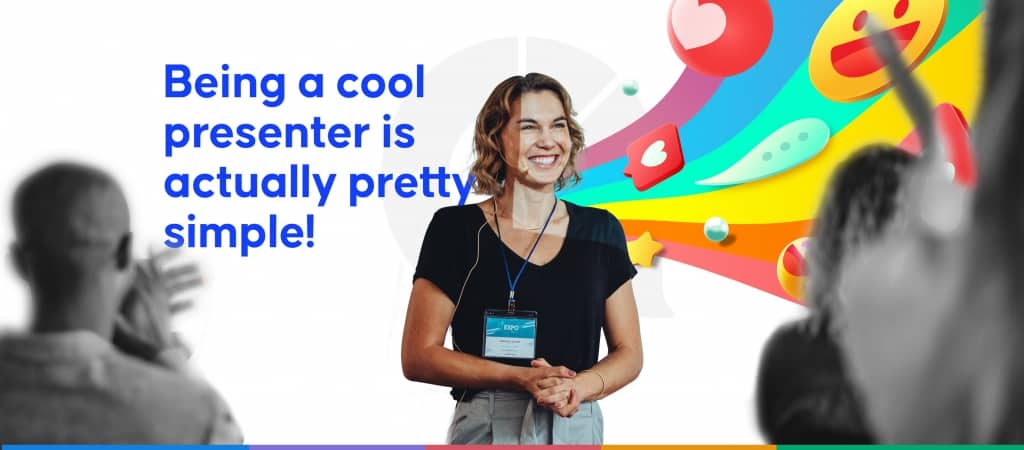
Zacznij od przedstawienia problemu lub pytania, na które odpowie Twoja prezentacja. „Prawdopodobnie wszyscy doświadczyliście frustracji związanej z… i to właśnie chcę omówić – jak możemy przezwyciężyć…”
Podziel się swoim najważniejszym wnioskiem jako zwięzłym wezwaniem do działania. „Kiedy dziś stąd wyjdziesz, chcę, żebyś zapamiętał jedną rzecz… ponieważ zmieni ona sposób, w jaki…”
Refer to a current event or industry trend to show relevance. “In light of [what��s happening], understanding [topic] has never been more critical for success in…”
Odnieś swoją wiadomość do tego, co jest dla nich najważniejsze. „Jako [typ ludzi, którymi są], wiem, że Twoim priorytetem jest… Więc wyjaśnię dokładnie, jak to może Ci pomóc osiągnąć…”
Zaprezentuj intrygującą perspektywę. „Podczas gdy większość ludzi patrzy na [problem] w ten sposób, wierzę, że szansa leży w spojrzeniu na niego z tej perspektywy…”
Połącz ich doświadczenie z przyszłymi spostrzeżeniami. „To, z czym się do tej pory zmierzyłeś, będzie miało o wiele więcej sensu po zbadaniu…”
Celem jest przyciągnięcie uwagi poprzez przedstawienie korzyści, jakie zyskasz, by mieć pewność, że kontekst nie zostanie pominięty.
#3. Mów krótko
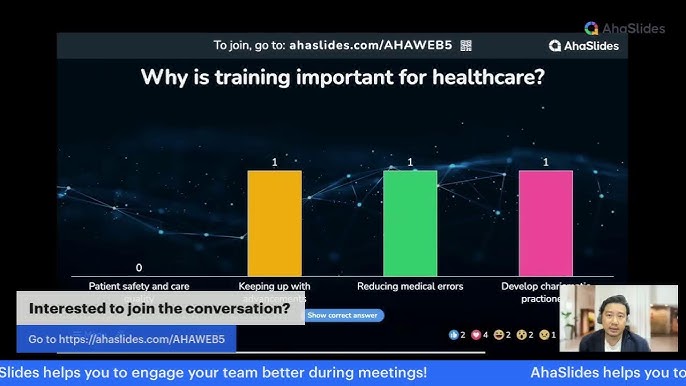
Jeśli chodzi o wprowadzenia przed występem, mniej znaczy naprawdę więcej. Masz tylko 30 sekund, aby zrobić piorunujące wrażenie, zanim zacznie się prawdziwa zabawa.
Może to nie brzmi jak dużo czasu, ale to wszystko, czego potrzebujesz, aby wzbudzić ciekawość i rozpocząć swoją historię z hukiem. Nie marnuj ani chwili na wypełniacze – każde słowo to okazja, aby oczarować odbiorców.
Zamiast bez przerwy brzęczeć, zastanów się nad zaskoczeniem ich intrygujący cytat lub odważne wyzwanie związane z tym, kim jesteś. Nadaj tyle smaku, aby wystarczyło na kilka sekund, nie psując przy tym pełnego posiłku.
Jakość ponad ilość to tutaj magiczny przepis. Zapakuj maksymalny efekt w minimalne ramy czasowe, nie tracąc ani jednego pysznego szczegółu. Twoje wprowadzenie może trwać tylko 30 sekund, ale może wywołać reakcję, która będzie trwać przez całą prezentację.
#4. Zrób nieoczekiwane
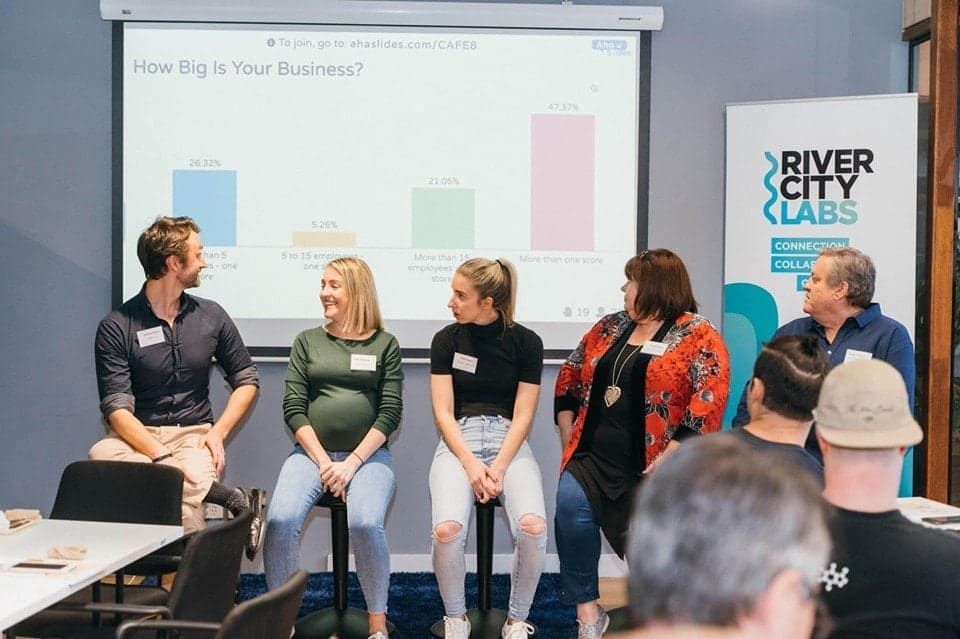
Zapomnij o tradycyjnym „cześć wszystkim…”, od razu przyciągnij uwagę publiczności, dodając do prezentacji elementy interaktywne.
68% osób powiedz, że łatwiej jest zapamiętać informacje, gdy prezentacja jest interaktywna.
Możesz zacząć od ankiety przełamującej lody i zapytać wszystkich, jak się czują, lub pozwolić im na to zagraj w quiz, aby dowiedzieć się czegoś o sobie i temacie, o którym usłyszą naturalnie.
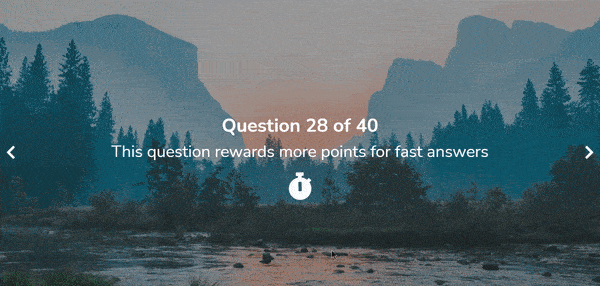
Oto w jaki sposób interaktywne oprogramowanie do prezentacji, takie jak AhaSlides, może przenieść Twoje wprowadzenie na wyższy poziom:
- AhaSlides oferuje mnóstwo typów slajdów dla Ciebie Polling, Quiz, Q & A, chmura słów or pytanie otwarte żądania. Niezależnie od tego, czy przedstawiasz się wirtualnie, czy osobiście, Funkcje AhaSlides są Twoimi najlepszymi pomocnikami, którzy przyciągną do Ciebie wzrok wszystkich!
- Wyniki są wyświetlane na żywo na ekranie prezentera, przyciągając uwagę publiczności przyciągającymi wzrok projektami.
- Możesz zintegrować AhaSlides ze swoim popularnym oprogramowaniem do prezentacji, takim jak PowerPoint or interaktywne Prezentacje Google z AhaSlides.
#5. Podgląd kolejnych kroków

Istnieje kilka sposobów, aby pokazać, dlaczego Twój temat jest ważny, na przykład:
Zadaj palące pytanie i obiecaj odpowiedź: „Wszyscy kiedyś zadaliśmy sobie pytanie – jak osiągnąć X? Cóż, pod koniec naszego wspólnego czasu zdradzę trzy niezbędne kroki”.
Podsuwaj cenne wnioski: „Kiedy stąd wyjdziesz, chcę, żebyś wyszedł z narzędziami Y i Z w tylnej kieszeni. Przygotuj się na podniesienie poziomu swoich umiejętności”.
Wyobraź to sobie jako podróż: „Odkryjemy wiele rzeczy, podróżując z punktu A do B i do C. Pod koniec twoja perspektywa ulegnie zmianie”.
Przedstaw się stylowo dzięki AhaSlides
Zachwyć odbiorców interaktywną prezentacją o sobie. Daj im poznać Cię lepiej poprzez quizy, ankiety i pytania i odpowiedzi!
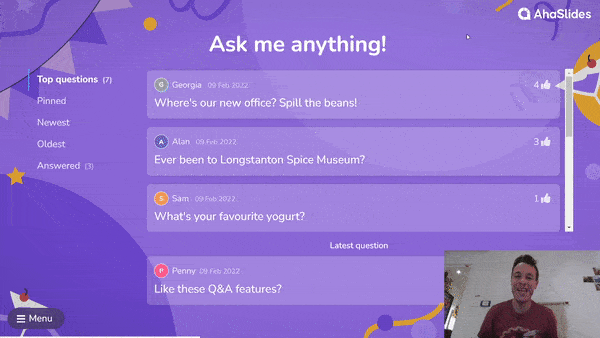
Rozbudź pilność: „Mamy tylko godzinę, więc musimy działać szybko. Przeprowadzę nas przez sekcje 1 i 2, a następnie wdrożysz to, czego się nauczysz, w działanie w zadaniu 3”.
Działania podglądowe: „Po zakończeniu ram, bądźcie gotowi zakasać rękawy podczas naszego ćwiczenia praktycznego. Zaczyna się czas współpracy…”
Obiecaj nagrodę: „Kiedy pierwszy raz nauczyłem się robić X, wydawało się to niemożliwe. Ale na mecie powiesz sobie: „Jak mogłem żyć bez tego?”
Spraw, by zastanawiali się: „Każdy przystanek dostarcza więcej wskazówek, aż na końcu czeka na Ciebie wielkie odkrycie. Kto jest gotowy na rozwiązanie?”
Pozwól widzom zobaczyć twój flow jako ekscytującą progresję wykraczającą poza zwykły zarys. Ale nie obiecuj powietrza, wnieś coś namacalnego do stołu.
#6. Przeprowadzaj pozorowane rozmowy

Perfekcyjna prezentacja wymaga mnóstwa czasu na zabawę przed występem. Przećwicz intro tak, jakbyś był na scenie – nie ma miejsca na próby w połowie prędkości!
Nagraj siebie, aby uzyskać informację zwrotną w czasie rzeczywistym. Oglądanie odtwarzania to jedyny sposób, aby wykryć niezręczne pauzy lub frazy uzupełniające proszące się o klocek do krojenia.
Przeczytaj swój scenariusz w lustrze, aby zobaczyć prezencję gałki ocznej i charyzmę. Czy Twoja mowa ciała przynosi to do domu? Wzmocnij atrakcyjność wszystkich zmysłów, aby uzyskać całkowite zniewolenie.
Ćwicz poza książką, aż intro wypłynie na powierzchnię twojego umysłu niczym oddech. zinternalizuj go, aby zabłysnąć bez fiszek jako pomocy.
Wygłaszaj pozorowane przemówienia dla rodziny, przyjaciół lub futrzastych sędziów. Żadna scena nie jest zbyt mała, gdy dopracowujesz swoją rolę, aby zabłysnąć.
💡 Dowiedz się więcej: Jak przedstawić się jak profesjonalista
Podsumowanie
I oto masz – sekrety Rockingu. Twojego. Wstępu. Bez względu na wielkość Twojej publiczności, te wskazówki w mgnieniu oka przyciągną wszystkie oczy i uszy.
Ale pamiętaj, że praktyka nie służy tylko perfekcji – służy pewności siebie. Przeżyj te 30 sekund jak prawdziwa gwiazda. Uwierz w siebie i swoją wartość, bo oni odwzajemnią się tym samym.
Najczęściej zadawane pytania
Jak się przedstawić przed prezentacją?
Zacznij od podstawowych informacji, takich jak imię i nazwisko, stanowisko/stanowisko i organizacja, zanim przedstawisz temat i zarys.
Co powiesz na przedstawienie się podczas prezentacji?
Przykład zrównoważonego wprowadzenia może wyglądać następująco: „Dzień dobry, nazywam się [Twoje imię] i pracuję jako [Twoja rola]. Dzisiaj będę mówił o [Temacie] i mam nadzieję, że na koniec dam Ci [Cel 1], [Cel 2] i [Cel 3], aby pomóc Ci w [Kontekstie tematu]. Zaczniemy od [Sekcji 1], następnie [Sekcji 2], a na koniec przejdziemy do [Wniosku]. Dziękuję za przybycie, zaczynajmy!”
Jak przedstawić się podczas prezentacji klasowej jako uczeń?
Kluczowe kwestie, które należy poruszyć w prezentacji zajęć, to nazwa, kierunek, temat, cele, struktura i zaproszenie do udziału publiczności/pytania.

